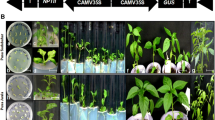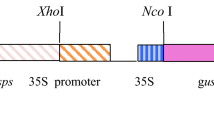Abstract
The use of antibiotic or herbicide resistant genes as selection markers for production of transgenic plants and their continuous presence in the final transgenics has been a serious problem for their public acceptance and commercialization. MAT (multi-auto-transformation) vector system has been one of the different strategies to excise the selection marker gene and produce marker-free transgenic plants. In the present study, ipt (isopentenyl transferase) gene was used as a selection marker gene. A chitinase gene, ChiC (isolated from Streptomyces griseus strain HUT 6037) was used as a gene of interest. ChiC gene was cloned from the binary vector, pEKH1 to an ipt-type MAT vector, pMAT21 by gateway cloning and transferred to Agrobacterium tumefaciens strain EHA105. The infected tuber discs of potato were cultured on hormone- and antibiotic-free MS medium. Seven of the 35 explants infected with the pMAT21/ChiC produced shoots. The same antibiotic- and hormones-free MS medium was used in subcultures of the shoots (ipt like and normal shoots). Molecular analyses of genomic DNA from transgenic plants confirmed the integration of gene of interest and excision of the selection marker in 3 of the 7 clones. Expression of ChiC gene was confirmed by Northern blot and western blot analyses. Disease-resistant assay of the marker-free transgenic, in vitro and greenhouse-grown plants exhibited enhanced resistance against Alternaria solani (early blight), Botrytis cinerea (gray mold) and Fusarium oxysporum (Fusarium wilt). From these results it could be concluded that ipt gene can be used as a selection marker to produce marker-free disease-resistant transgenic potato plants on PGR- and antibiotic-free MS medium.








Similar content being viewed by others
References
Ballester R, Cervera M, Peña L (2007) Efficient production of transgenic citrus plants using isopentenyl transferase positive selection and removal of the marker gene by site-specific recombination. Plant Cell Rep 26:39–45
Ballester A, Cervera M, Peña L (2010) Selectable marker-free transgenic orange plants recovered under non-selective conditions and through PCR analysis of all regenerants. Plant Cell Tiss Organ Cult 102(3):329–336. doi:10.1007/s11240-010-9737-1
Boller T (1988) Ethylene and the regulation of antifungal hydrolases in plants. Oxf Surv Plant Mol Cell Biol 5:145–174
Broekaert WF, Cammue BPA, De Bolle MFC, Thevissen K, de Samblanx GW, Osborn RW (1997) Antimicrobial peptides from plants. Crit Rev Plant Sci 16:297–323
Carr JP, Klessig DF (1989) The pathogenesis-related proteins of plants. Genet Eng 11:65–109
Cui M, Takayanagi K, Kamada H, Nishimura S, Handa T (2000) Transformation of Antirrhinum majus L. by a rol-type multi-auto-transformation (MAT) vector system. Plant Sci 159:273–280
Cui M, Takayanagi K, Kamada H, Nishimura S, Handa T (2001) Efficient shoot regeneration from hairy roots of Antirrhinum majus L. transformed by the rol-type MAT vector system. Plant Cell Rep 20:55–59
Dale PJ (1992) Spread of engineered genes to wild relatives. Plant Physiol 100:13–15
Darbani B, Elimanifar A, Stewart CN, Camargo WN (2007) Methods to produce marker-free transgenic plants. Biotechnol J 2:83–90
de Vetten N, Wolters AM, Raemkers K, Meer I, Stege R, Heeres E, Heeres P, Visser R (2003) A transformation method for obtaining marker-free plants of a cross-pollinating and vegetatively propagated crop. Nat Biotechnol 21:4339–4442
Ebinuma H, Komamine A (2001) MAT (multi-auto-transformation) vector system. The oncogenes of Agrobacterium as positive markers for regeneration and selection of marker-free transgenic plants. In Vitro Cell Dev Biol Plant 37:103–113
Ebinuma H, Sugita K, Matsunaga E, Yamakado M (1997a) Selection of marker-free transgenic plants using the isopentenyl transferase gene. Proc Natl Acad Sci USA 99:2117–2121
Ebinuma H, Sugita K, Matsunaga E, Yamakado M (1997b) Principle of MAT vector system. Plant Biotechnol 14:133–139
Ebinuma H, Sugita K, Matsunaga E, Endo S, Yamada K, Komamine A (2001) Systems for the removal of a selection marker and their combination with a positive marker. Plant Cell Rep 20:383–392
Endo S, Kasahara T, Sugita K, Ebinuma H (2002) A new GSTMAT vector containing both ipt and iaaM/H genes can produce marker-free transgenic tobacco plants with higher frequency. Plant Cell Rep 20:923–928
Gleave AP, Mitra DS, Mudge SR, Morris BAM (1999) Selectable marker-free transgenic plants without sexual crossing: transient expression of cre recombinase and use of a conditional lethal dominant gene. Plant Mol Biol 40:223–235
Gressel J (1992) Indiscriminate use of selectable markers: sowing wild oats? TIBTECH 10:382
Hare P, Chua N-H (2002) Excision of selectable marker genes from transgenic plants. Nat Biotechnol 20:575–580
Hohn B, Levy A, Putcha H (2001) Elimination of selection markers from transgenic plants. Curr Opin Biotechnol 12:139–143
Ivana M, Lidiya S, Milo O, Oksana Z, Tatyana K, Josef E, Jaroslava O, Svetlana G, Yurii R, Nina A (1997) Growth pattern, tuber formation and hormonal balance in in vitro potato plants carrying ipt gene. Plant Growth Regul 21:27–36
Jaiwal PK, Sahoo L, Singh ND, Singh RP (2002) Strategies to deal with the concern about marker genes in transgenic plants: some environment friendly approaches. Curr Sci 83:128–136
Jefferson RA (1987) Assaying chimeric genes in plants: the GUS gene fusion system. Plant Mol Biol Rep 5:387–405
Johnson KB, Radcliffe EB, Teng PS (1986) Effects of interacting populations of Alternaria solani, Verticillium dahliae, and potato leafhopper (Empoasca fabae) on potato yield. Phytopathology 76:1046–1052
Khan RS, Chin DP, Nakamura I, Mii M (2006) Production of marker-free Nierembergia caerulea using MAT vector system. Plant Cell Rep 25:914–919
Khan RS, Sjahril R, Nakamura I, Mii M (2008) Production of transgenic potato exhibiting enhanced resistance to fungal infections and herbicide applications. Plant Biotechnol Rep 2:13–20
Khan RS, Nakamura I, Mii M (2010a) Production and selection of marker-free transgenic plants of Petunia hybrida using site-specific recombination. Biol Plant 54:265–271
Khan RS, Thirukkumaran G, Nakamura I, Mii M (2010b) Rol (root loci) gene as a positive selection marker to produce marker-free Petunia hybrida. Plant Cell Tiss Organ Cult 101:279–285
Komari T, Hiei Y, Saito Y, Murai N, Kumashiro T (1996) Vectors carrying two separate T-DNAs for co-transformation of higher plants mediated by Agrobacterium tumefaciens and segregation of transformants free from selection markers. Plant J 10:165–174
Laemmli UK (1970) Cleavage of structural proteins during the assembly of the head of bacteriophage T4. Nature 227:680–685
Lu L, Wu X, Yin X, Morrand J, Chen X, Folk WR, Zhang ZJ (2009) Development of marker-free transgenic sorghum [Sorghum bicolor (L.) Moench] using standard binary vectors with bar as a selectable marker. Plant Cell Tiss Organ Cult 99:97–108
Matsunaga E, Sugita K, Ebinuma H (2002) Asexual production of selectable-marker free transgenic woody plants, vegetatively propagated species. Mol Breed 10:95–106
Murashige T, Skoog F (1962) A revised medium for rapid growth and bioassays with tobacco tissue cultures. Physiol Plant 15:473–497
Nap JP, Bijvoet J, Stikema WJ (1992) Biosafety of kanamycin resistant plants: an overview. Transgenic Res 1:239–249
Ohno T, Armand S, Hata T, Nikaidou N, Henrissat B, Mitsutomi M, Watanabe T (1996) A modular family 19 chitinase found in the prokaryotic organism Streptomyces griseus HUT 6037. J Bacteriol 178:5065–5070
Pelletier JR (1988) Computer simulation of cultivar resistance and fungicide effects on epidemics of potato early blight. PhD thesis, Cornell University, Ithaca, NY
Puchta H (2000) Removing selectable marker genes: taking the shortcut. Trends Plant Sci 5:273–274
Rogers OS, Bendich JA (1988) Extraction of DNA from plant tissues. In: Gelvin SB, Schiliperoort RA, Verma DPS (eds) Plant molecular biology manual. Kluwer, Dordrecht, A6:1–10
Roy SD, Saxena M, Bhomkar PS, Pooggin M, Hohn T, Sarin NB (2008) Generation of marker-free salt tolerant transgenic plants of Arabidopsis thaliana using the gly I gene and cre gene under inducible promoters. Plant Cell Tiss Organ Cult 95:1–11
Saelim L, Phansiri S, Suksangpanomrung M, Netrphan S, Narangajavana J (2009) Evaluation of a morphological marker selection and excision system to generate marker-free transgenic cassava plants. Plant Cell Rep 28:445–455
Sambrook J, Russell DW (2001) Molecular cloning. A laboratory manual. Cold Spring Harbor Laboratory Press, Cold Spring Harbor
Scaramelli L, Balestrazzi A, Bonadei M, Piano E, Carbonera D, Confalonieri M (2009) Production of transgenic barrel medic (Medicago truncatula Gaernt.) using the ipt-type MAT vector system and impairment of recombinase-mediated excision events. Plant Cell Rep 28:197–211
Sugita K, Matsunaga E, Ebinuma H (1999) Effective selection system for generating marker-free transgenic plants independent of sexual crossing. Plant Cell Rep 18:941–947
Sugita K, Matsunaga E, Kasahara T, Ebinuma H (2000) Transgene stacking in plants in the absence of sexual crossing. Mol Breed 6:529–536
Thirukkumaran G, Khan RS, Chin DP, Nakamura I, Mii M (2009) Isopentenyl transferase gene expression offers the positive selection of marker-free transgenic plant of Kalanchoe Blossfeldiana. Plant Cell Tissue Organ Cult 97:237–242
Walter RS, Rosemary L, Gary DF, Weingartner DP (2001) Compendium of potato diseases (APS compendium of plant disease series). American Phytopathological Society, St Paul
Watanabe T, Kanai R, Kawase T, Tanabe T, Mitsutomi M, Sakuda S, Miyashita K (1999) Family 19 chitinases of Streptomyces species: characterization and distribution. Microbiology 145:3353–3363
Weigel D, Glazebrook J (2006) Transformation of Agrobacterium using the freeze–thaw method. Cold Spring Harb Protoc. doi:10.1101/pdb.prot4666
Yoder JI, Goldsbrough AP (1994) Transformation systems for generating marker-free transgenic plants. Biotechnology 12:263–267
Zelasco S, Ressegotti V, Confalonieri M, Carbonera D, Calligari P, Bonadei M, Bisoffi S, Yamada K, Balestrazzi A (2007) Evaluation of MAT-vector system in white poplar (Populus alba L.) and production of ipt marker-free transgenic plants by ‘single-step transformation’. Plant Cell Tissue Organ Cult 91:61–72
Zhang Y, Liu H, Li B, Zhang JT, Li Y, Zhang H (2009) Generation of selectable marker-free transgenic tomato resistant to drought, cold and oxidative stress using the Cre/loxP DNA excision system. Transgenic Res 18:607–619
Zubko E, Scutt C, Meyer P (2000) Intrachromosomal recombination between attP regions as a tool to remove selectable marker genes from tobacco transgenes. Nat Biotechnol 18:442–445
Acknowledgments
We are very grateful to Japan Society for Promotions of Sciences (JSPS) for their financial support for this research project. We are also thankful to Pulp and Paper Research group, Nippon Paper Industries, Tokyo, who kindly provided the MAT vector constructs.
Author information
Authors and Affiliations
Corresponding authors
Additional information
Communicated by H. Ebinuma.
Rights and permissions
About this article
Cite this article
Khan, R.S., Ntui, V.O., Chin, D.P. et al. Production of marker-free disease-resistant potato using isopentenyl transferase gene as a positive selection marker. Plant Cell Rep 30, 587–597 (2011). https://doi.org/10.1007/s00299-010-0974-x
Received:
Revised:
Accepted:
Published:
Issue Date:
DOI: https://doi.org/10.1007/s00299-010-0974-x




